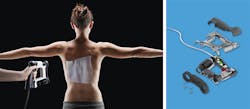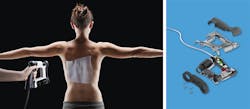Lighting and Illumination: Pattern projector aids prosthetics maker
A maker of 3D scanning systems for custom prosthetics needed a stable, accurate way to project light patterns on to people's bodies to improve the speed and accuracy of the prosthetic and orthotic design process. The solution needed to be compact enough to fit in a handheld device, provide the required accuracy, and be safe for users and operators.
Based in Vancouver, BC, Canada; Vorum is one of the world's leading makers of prosthetics and orthotics (P&O) using computer-aided design and computer-aided manufacturing (CAD/CAM). Founded in 1989 by Carl Saunders, Vorum had been researching CAD/CAM as a more precise and efficient way to design and make prosthetics and orthotics for more than a decade before it opened for business. Saunders gave the first public demonstration of a computer-aided design and manufacturing system for P&O professionals in 1983.
While Vorum was in the process of developing a portable, handheld 3D structured-light scanner that would allow P&O professionals to take advantage of CAD technology in speeding up the process of making prosthetics and orthotics by eliminating the need for plaster casts.
The new product, called Spectra, was designed to be used in tandem with an LED projector and a single camera to capture a 3D image. Along with Vorum's seven-axis robotic carving system, it utilizes a touch screen and software customized for carving prosthetic and orthotic shapes. Spectra also creates electronic files to make up an easily accessible library of images and to document how a patient's shape and volume changes over time.
The projector is situated at one end of the Spectra, with the camera at the other end. The projector projects an encoded pattern onto the body, which the camera records. The integrated software processes the resulting digital image, allowing the user to take 3D information from the projected pattern on the body.
While getting Spectra ready for market, Vorum shopped for a structured light projector that would fit on the scanner and properly illuminate the subject so that the integrated camera could work more efficiently. Vorum chose to use the SP30 series LED structured light pattern projector from Smart Vision Lights (SVL; Muskegon, MI, USA;www.smartvisionlights.com).
Using a 5-watt LED, the SP30 can be used to project any user-selectable pattern.With an internal current-based LED driver capable of strobe output, the new light source met all of Vorum's compact size requirements and provided an intense projected spot size.
"We did not want a laser-based source because of the additional safety/risk overhead," said Vorum CTO Ed Grochowski. "It is also a potential objection to overcome for our typical customer applications, such as scanning patients.
"Smart Vision Lights' product offered the combination of requisite brightness, form factor, power requirements and size," added Grochowski. "These were the main technical drivers."
Along with the SP30's form factor and intensity level, Vorum also cited the SP30's durability and price in making it the right fit for the Spectra scanner.

